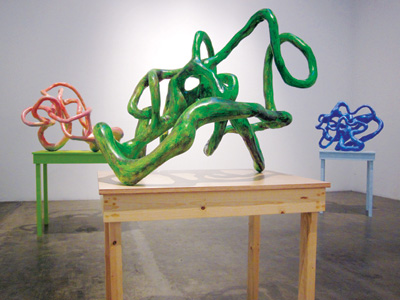
Patrick Nickell understands Modernism with all its complex implications, how at the heart of the modernist impulse is a pervasive self-consciousness, the desire to externalize the invisible, to clarify the ineffable, physicalizing objects in time and space. Nickell excels at using simple materials in the service of seductively capricious sculptural abstraction; his 2008 show at Rosamund Felsen featured giant, squiggly colored bands of plywood and cardboard, which filled the room from floor to wall. As seen this February at Santa Monica's Rosamund Felsen Gallery, Nickell's newest efforts have born some extraordinary and wild fruit: a series of sculptures, set on table-like bases, that expand and retract simultaneously into the surrounding space. Like modernism itself, perhaps, Nickell's approach seems focused largely on processes and materials utilized toward a greater abstraction. In today's cultural climate, modernism could arguably be seen as suggesting an esoteric set of strategies, yet the impulse toward newness and expansion is still vital and very much alive in Nickel's work, in which it has found, if not necessarily a new form, then an innovative and persuasive extension beyond the usual.
Nickell's chosen title for the show, "The Lending Library Lends A Hand," identifies itself as a linguistic conundrum, and is an essentially self-reflexive statement. The relationship between the title of the show and the sculptural works themselves is fluid and abstract (another modernist correlation), yet at the heart of Nickell's process is the articulation of lines and forms in space, as though the artist were drawing directly onto the air itself, or the sculptures were poised there in abeyance to some greater gesture occurring spontaneously within nature. Nickell differentiates the works through color and shape, but also incorporates the pedestals--very simple wooden tables--as a means of setting off the sculptures. Many of the sculptures, made from acrylic, plaster and metal armatures and hand painted in bright colors, reference physical human gestures such as Wrestling Club (ochre), 2010, which is shown on a bright orange table. This work in particular mimics strange amorphous bodies writhing in space, albeit entirely through the use of abstract line and form. The inherent metaphor of wrestling bodies is strongly implied, yet nothing concrete is actually represented. Instead, Nickell utilizes line as metaphor, and this is what makes these works so successful and aligns them with a modernist tradition. The sculpture with its pristine bronze finish also suggests the lithe bodies of Greek and Roman athletes, perfected as they were for supreme athleticism; the flowing lines in this work echo the movement, grace and beauty of bodies through space.
Other works are more obviously whimsical, such as Circus Clown Fire Brigade (orange), 2010, which is bright fire engine red and seems nearly to explode upwards from the quaint blue pedestal on which it rests. This work, like the others in this exhibition, has its own distinct personality and expounds on a particular visual gesture. The bright red color and twisty turning visual vernacular coupled here with the title suggests a more emphatic linguistic system that borders on the absurd. Other works, like the more somber Bony (gray), 2010, chart a shifting mood that appears more subdued and introspective as does Roaring (white), 2010, a stolid white sculpture set atop a black and green table. Again the mood here is much more somber and internalized, as though the winding negative space of the sculpture had been extracted somehow out of the darkness below it.
Modernism posited a rupture in the continuity of thought and imagination. Similarly, each of Nickell's sculptures acts as a visual amplification of a single, incontrovertible gesture, at once modern and contemporary. It's as though each of these sculptures were a different guest at the same extraordinary dinner party. The imagined conversations are heightened, and the presence of each work signifies the next.
Nickell, who was born in Van Nuys, CA in 1960, says that "a driving theme [in his work] is the displacement of mass, and formal, linear mass in particular" and that with these "unabashed objects" he is "reaching back to look forward in terms of a formal approach to form." One has the sense that these works have been imagined in accordance with a dialogue with other artists, specifically modernist artists like Constantin Brancusi and Karl Benjamin, and indeed Nickell references these artists, especially in the relationship between the pedestals and the pieces themselves. "The pedestals came out of the desire to not have a sea of neutral white platforms that would just kill the space," Nickell says, and the integration of the platforms with the sculptures completes the modernist gesture, as is the case with Brancusi where the geometry of the bases echoes the forms they support.
Ultimately, Nickell continues to create visually compelling work that resonates formally and contextually with a supreme modernist aesthetic, and it's wonderful to see an artist embrace such a complex and mutable heritage so completely. His sculptures erupt with formal wit and vigor even as they recede back into themselves, lovely and all of a piece.
This article was written for and published in art ltd. magazine ![]()
